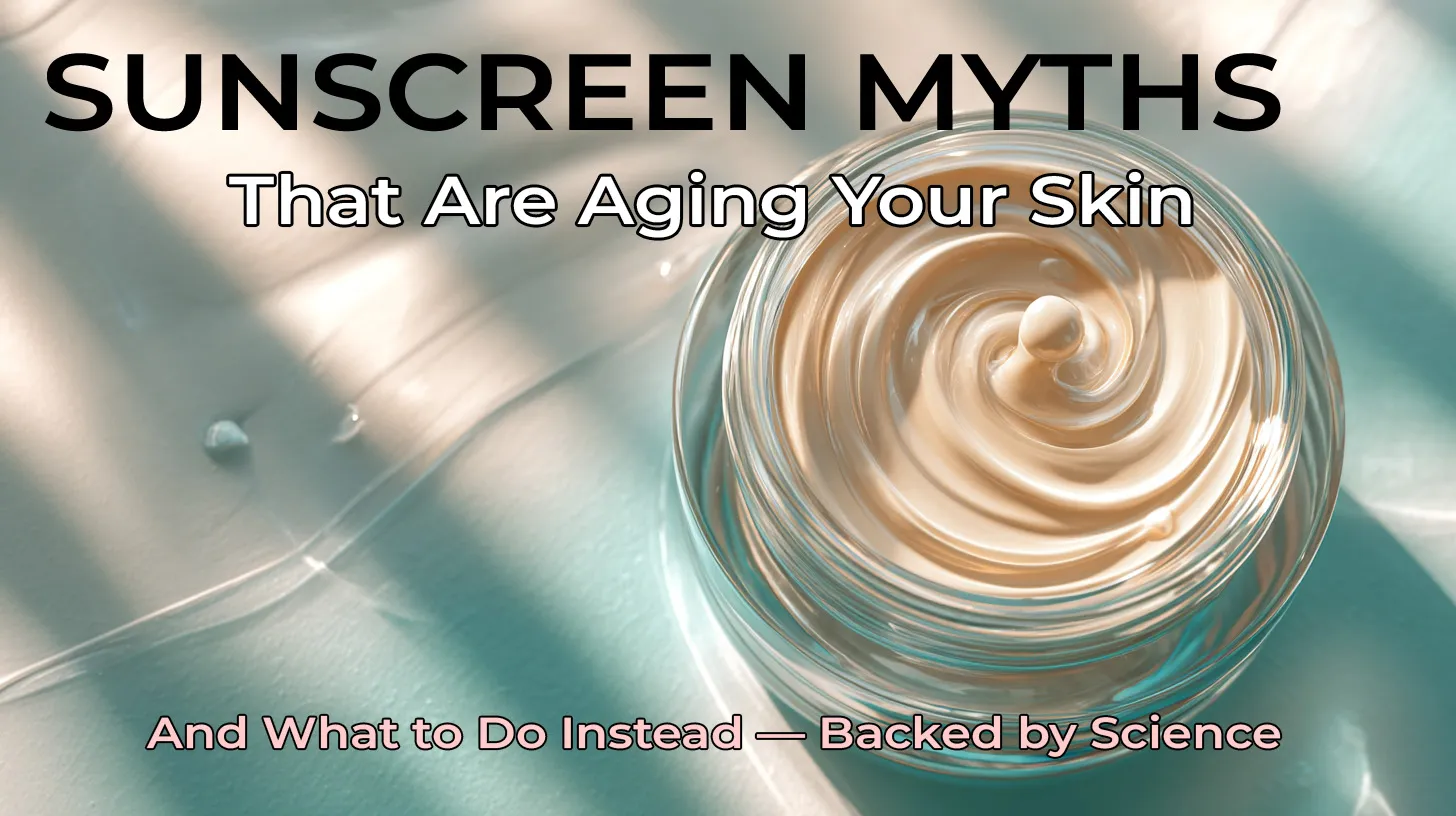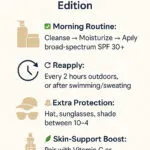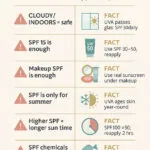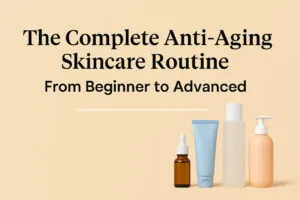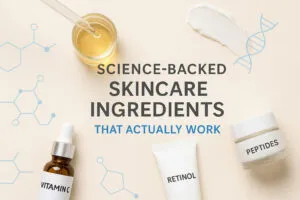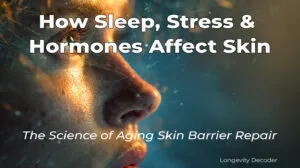The Hidden Truth About Sunscreen and Aging
People commonly believe sunscreen only matters during hot summer days. The truth is that UV exposure causes the most significant visible skin aging effects, surpassing the impact of genetic factors, dietary choices, and stress levels.
The leading cause of skin aging signs, including fine lines, dark spots, sagging skin, and rough texture, is photoaging, which results from prolonged UV exposure. People who apply sunscreen often continue using methods that speed up skin aging.
The Ultimate Guide to Anti-Aging Skincare explains that daily protection serves as the essential base for any successful skincare program. The guide examines common sunscreen myths that damage your skin and provides dermatologist-recommended, research-based instructions for proper SPF application to achieve absolute age protection.
Myth #1: “I Don’t Need Sunscreen When It’s Cloudy or Indoors”
The Myth:
Your skin remains protected from harm because the sun is not directly shining.
The Science:
The sun’s UV rays manage to pass through clouds at a rate of 80–90% while UVA rays, which cause collagen breakdown, penetrate glass windows without any obstruction. Your skin receives photoaging light exposure during your daily activities, including your commute, working at a windowed desk, and your walks under cloudy skies.
What to Do Instead:
You should apply broad-spectrum sunscreen with SPF 30 or higher to your skin each day, regardless of weather conditions. Zinc oxide and avobenzone serve as effective UVA blockers, which you should look for in your sunscreen products. Your skin requires daily protection through sunscreen application, just like your teeth need daily brushing.
Myth #2: “SPF 15 Is Enough for Daily Use”
The Myth:
SPF 15 protects 93% of UVB rays, so it should be sufficient for daily use.
The Science:
SPF ratings measure protection against UVB rays, which cause sunburns, but they do not protect against UVA rays, which lead to skin aging and permanent damage. The actual protection from SPF 15 products becomes equivalent to SPF 5–8 because people usually apply less than half of the recommended amount.
What to Do Instead:
Apply SPF 30–50 sunscreen to your skin before going outside, using enough product to cover your face and neck with a quarter-teaspoon amount. You should reapply sunscreen every two hours when spending time outdoors or right after sweating or toweling off. A higher SPF rating provides additional protection, but it does not extend your time spent under the sun.
Myth #3: “Makeup with SPF is All I Need.”
The Myth:
Your foundation or BB cream contains SPF 30, so you can skip using additional sunscreen protection.
The Science:
You would need to apply six to seven times more foundation than your regular amount to achieve the SPF protection shown on the label. The thin application of most makeup products fails to create an effective UV protection barrier, and SPF sprays and powders do not provide consistent coverage.
What to Do Instead:
Apply sunscreen as your base protection before adding makeup with SPF for additional defense. Choose lightweight, non-greasy sunscreens that work well under makeup products because “gel cream” and “fluid” textures provide the best results.
Myth #4: “I Only Need Sunscreen at the Beach or in Summer”
The Myth:
People believe sunscreen should be used only during beach visits and summer months instead of every day.
The Science:
UVA radiation maintains its strength throughout the entire year because it passes through both cloud cover and car glass. The combination of winter snow and sand surfaces leads to higher UV radiation exposure. Dermatologists agree that people who maintain healthy skin aging patterns use sunscreen daily as their primary protective measure.
What to Do Instead:
Apply sunscreen as part of your daily morning routine year-round. The application process takes less than thirty seconds to protect your skin from decades of visible damage. The anti-aging benefits of sunscreen will grow stronger with each passing year when used as a daily habit.
Myth #5: “Higher SPF Means I Can Stay in the Sun Longer”
The Myth:
SPF 100 provides complete protection so you can stay outside for the entire day.
The Science:
The protection level between SPF 30 and SPF 100 shows only a 2% difference in their ability to block UVB rays. SPF 30 protects against 97% of UVB rays, but SPF 100 provides 99% protection, resulting in a 2% difference in protection. People who use high SPF numbers become more confident in their sun protection, which results in more prolonged sun exposure and increased damage from UVA rays.
What to Do Instead:
Select broad-spectrum SPF 30–50 sunscreen products and concentrate on applying sunscreen correctly and reapplying it instead of seeking higher SPF values. You should apply sunscreen every two hours while staying under shade between 10 AM and 4 PM, and use protective clothing with a UPF rating for extended outdoor activities.
Myth #6: “Chemical Sunscreens Are Bad for You”
The Myth:
Chemical sunscreens penetrate through your skin, so they must contain toxic substances according to this belief.
The Science:
The FDA, along with dermatologists, has confirmed that all approved sunscreen ingredients remain safe for use when people follow the recommended application instructions. The sunscreen ingredients oxybenzone and octinoxate have received criticism for causing skin irritation and damaging coral reefs, but they do not pose threats to human wellness.
What to Do Instead:
People with sensitive skin should use mineral-based sunscreens containing zinc oxide or titanium dioxide because these ingredients create a protective barrier on the skin surface. Modern sunscreen products known as hybrids use mineral and chemical filters to provide complete protection while avoiding the typical white residue.
Myth #7: “Sunscreen Causes Vitamin D Deficiency”
The Myth:
Sunscreen blocks UV rays, which supposedly stops your body from producing vitamin D.
The Science:
The process of vitamin D production in the body starts when UVB rays enter the skin. People who use sunscreen do not experience vitamin D deficiency because they either do not apply enough sunscreen or do not reapply it often enough to stop vitamin D production. Research indicates that people who use sunscreen regularly maintain typical vitamin D levels because they still get some sun exposure.
What to Do Instead:
You should continue using sunscreen protection because vitamin D supplements and food sources provide better benefits. People should obtain their daily vitamin D needs through food sources, including fatty fish, fortified milk, and supplements when necessary. People can easily regain their vitamin D levels, but cannot reverse sun-related damage to their skin.
How to Choose the Right Sunscreen for You
Every skin type benefits from sun protection — it’s just a matter of finding a formula you’ll actually enjoy using daily.
| Skin Type | Best Sunscreen Type | Key Ingredients |
|---|---|---|
| Oily / Acne-Prone | Lightweight gel or fluid | Avobenzone, Octisalate, or Hybrid formulas |
| Dry / Sensitive | Cream or lotion | Zinc oxide, Titanium dioxide, Ceramides |
| Darker Skin Tones | Tinted or hybrid mineral | Iron oxides, Zinc oxide |
| Active / Outdoor | Water-resistant SPF 50 | Zinc oxide + chemical filters |
How to Build a “Sun Smart” Routine
Morning:
You should apply sunscreen as your last skincare step after moisturizing, but before starting your makeup application.
Reapply:
You need to reapply sunscreen every two hours when outside, but you should do it right away after swimming or sweating.
Bonus Protection:
You should use wide-brim hats, polarized sunglasses, and UPF-rated clothing for additional protection. The sun’s strongest UV rays occur between 10 AM and 4 PM, so stay in the shade during this time.
Boost Your Defense:
You should combine your sunscreen with Vitamin C or niacinamide antioxidants in your morning serum because these ingredients protect your skin from free radicals that pass through sunscreen.
The Real Anti-Aging Secret
Consistency beats intensity.
The Annals of Internal Medicine published research demonstrating that sunscreen users who applied sunscreen daily developed 24% less skin aging over 4.5 years, regardless of their starting age.
Sunscreen functions as a cellular age management tool that protects your skin cells.
Your next step should be to check out our guide, The Complete Anti-Aging Skincare Routine — your roadmap to combining sunscreen, antioxidants, and innovative actives for lasting results.
Further Reading
Green, A. C., Williams, G. M., Logan, V., & Strutton, G. M. (2013). Reduced melanoma after regular sunscreen use: randomized trial follow-up. Annals of Internal Medicine, 158(11), 781–790.
https://doi.org/10.7326/0003-4819-158-11-201306040-00002

